Ball Python shedding, health and humidiity are linked, and it’s important to keep humidity at 55-65%, except during a shed when it can be raised to 80%+. Keep reading to find out why.
What humidity for Ball Pythons?
As I mention above, these snakes need an ambient humidity level of 55-65% to be maintained at all times, apart from during a shed. This may seem like a very arbitrary number for a species that ranges across vast areas of Africa. Especially when you take into consideration the huge variety of habitats they’ve been found in, from dry forest and savannah to tropical rainforest. But to understand this humidity requirement, you need to take two things into consideration.
First, Ball Pythons spend a lot of time in refugia such as rodent burrows and sometimes termite mounds. Hiding places like these are more enclosed and lose less water through evaporation than open ground. In fact, just a couple of feet below the surface, water content is much higher, which is why plants and grasses have adapted to have longer, hydrophilic roots in areas subjected to a dry season or excessive heat. Ball Pythons are simply using the same method – going underground to find favourable humidity (and safety of course).
Second, in some areas of their geographic range, and during the wet season, Ball Pythons encounter humidity of 80%+. The problem is this level of humidity is not ideal in a very enclosed space like a vivarium because it leads to rapid bacterial growth. Humidity levels of over 80% are widely believed to contribute to respiratory infections and scale rot if combined with poor ventilation. In a natural setting, this level of humidity could be perfectly healthy for them, but in our homes it’s exceedingly difficult to maintain high humidity and great ventilation.
55-65% Humidity is the sweet spot!
In a nutshell, Ball Pythons don’t like to be too dry, and being too wet can impact their health. So, what we’re left with is this humidity sweet spot of 55-65% for general humidity. During a shed cycle, humidity can be raised to 80% or more, but only temporarily. I’ll cover this later in the post, but first let’s look at how to maintain humidity.
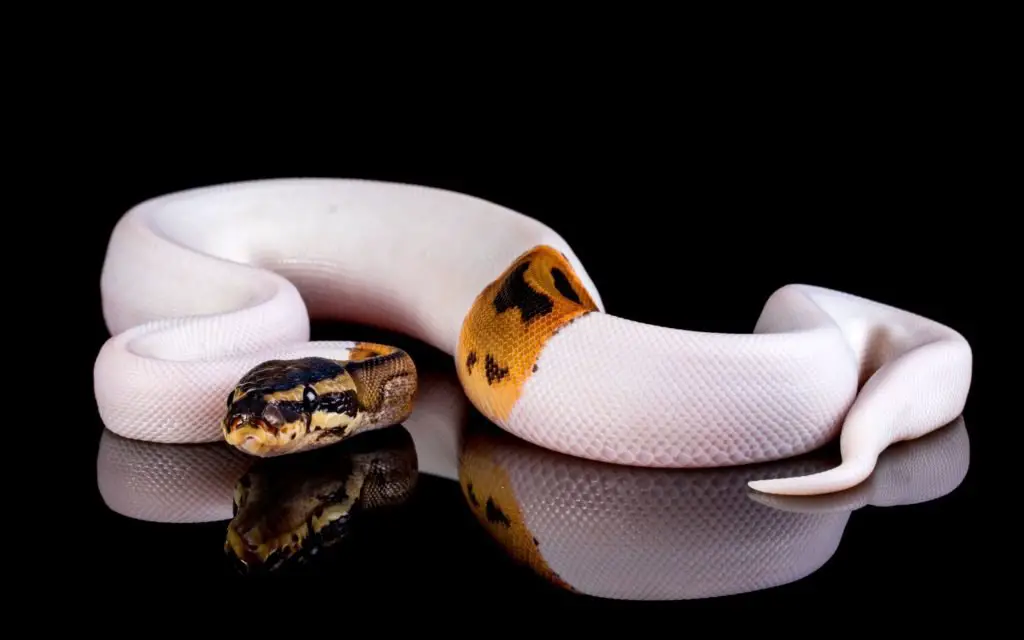
Tips for maintaining humidity
To maintain the correct humidity level, you obviously need to monitor it. There are two types of hygrometers (humidity gauges) you can use for this: analogue or digital. Cheap analogue hygrometers are available in most pet stores and work ok for a while until they decalibrate themselves and stop giving accurate readings! Digital hygrometers on the other hand are more expensive, but only stop working if they run out of batteries, in which case you simply replace them.
My advice is to get a decent digital hygrometer with a probe which you can fix to the wall of your snake’s enclosure. Place the probe close to the substrate level, away from any heat source, and you will get a reading of the humidity level they are experiencing. For a comparison of different hygrometers check out this article: Best Hygrometer For Reptiles 2021 – Reviews & Buyers Guide
Aside from getting a decent hygrometer, another thing to consider is the overall enclosure setup. In the enclosures section of this guide, I explain that enclosure type does affect humidity. In plastic tubs, humidity is easy to maintain, whereas in vivariums it can be quite difficult.
When you consider the fact that most terrarium/vivarium setups use ceramic heat emitters or heat bulbs – which dry out the air – it makes tubs even more attractive. This is something to take into consideration when setting up your pet’s enclosure.

Easy steps to maintain humidity
Obviously, I prefer tubs because of their hygienic nature and how easy it is to maintain humidity in them. Notwithstanding, you can maintain good humidity levels in any set-up if you put in the extra effort.
Let’s look at some steps you can take to do this:
- Spray the enclosure regularly with a water bottle. This is easy and effective. Be careful not to spray the snake in the face though, this can stress them.
- Use a larger water bowl. More water = more humidity. Simple!
- Place the water over/under a heat source. This makes more water evaporate into the air and increases humidity levels round the clock. Make sure it doesn’t prevent your pet getting to the heat source, however.
- Use hides with smooth surfaces and narrow entrances. These hides create a kind of micro-environment for your snake while they’re in them. In effect, when inside a hide, your snake’s exposure to the air is reduced and less moisture can evaporate from its scales. This measure doesn’t increase overall humidity but does help your pet weather unexpected decreases. Check out the hides below as examples.

Ball Python Shedding
Now I’ve included shedding and humidity in the post same post for a reason: healthy shedding relies on having the correct humidity! Bad sheds are a result of humidity that dips below 55%. That said, it’s important to understand why shedding is such an important part of a snake’s life and what it entails.
Often, we get this light-hearted, easy-peasy explanation that goes something like this: “shedding is sloughing off the old layer skin so your snake can grow”. It’s a little more complicated than that though.
Shedding is in fact a highly involved, stressful, and tiring time for a snake. In all Lepidosaurs, the subclass to which snakes belong, it is several layers of skin that differentiate and shed. The frequency and timing of this shedding is regulated hormonally.
First, their skin enters a renewal stage during which several layers of skin grow out of the deepest layer – the stratum germinativum. These new layers, called the inner generation layers, then grow under the previous layers, now called the outer generation layers. When the inner generation layers are finished and capped with a new Oberhautchen (tough outer layer), the outer generation layers are shed. In total, four layers of skin are shed at once. Now you know why I say it’s a little more complicated than we are often led to believe…
How long does it take a Ball Python to shed?
From start to finish, it takes an adult Ball Python over a week to complete its shed cycle. By shed cycle, I mean the four stages of shedding that we’ll discuss later in the article. When it comes to the actual act of sloughing off its old skin, it usually takes around twenty to thirty minutes.
In baby Ball Pythons, the whole process moves a lot more swiftly because of their faster growth rate and metabolism. A baby can go through a shed cycle in as little as three days and slough off its skin in ten minutes.
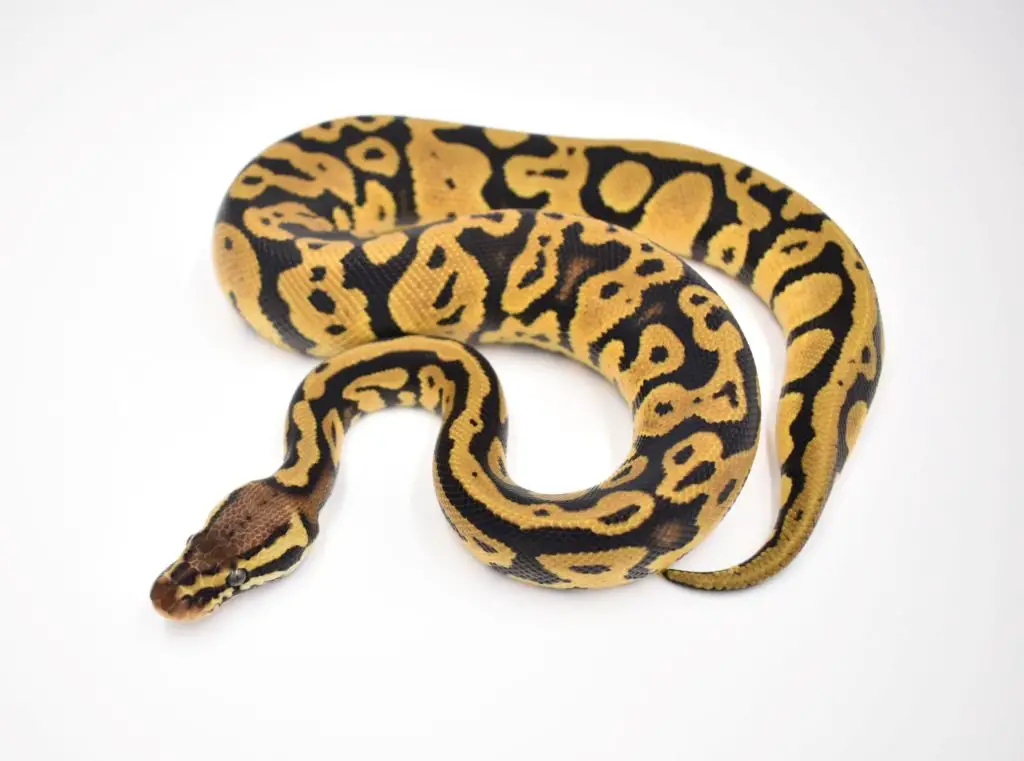
Will my snake eat while shedding?
Your snake probably will not eat during shedding. Overall, I’d say that roughly 95% of all my Ball Pythons refuse to eat while shedding. There are always exceptions of course, but when you think about it, there’s no rush to feed your snake anyway. If it’s shedding, just wait until it has finished.
Ball Pythons are notorious for fasting, and if they don’t eat for a week while shedding it will do them no harm whatsoever. Moreover, they will probably prefer that you do not offer them food at this time, what they really want is some peace and quiet.
When should I feed my Ball Python after it sheds?
My snakes are completely back to normal and ready to feed 48hrs after shedding. Many of them refuse to eat before this amount of time has gone by. It seems they just need a day or two to let the stress of the event wear off.
How do I know when my Ball Python is going to shed?
Before shedding, your Ball Python is going to go through a number of physiological changes that prepare its body for the process. Some of these changes will become visual, and it is by reading them that you know your Ball Python is going to shed.
I call these the four stages of shedding:
- Dark colouration. Your snake becomes, dark, drab, and lacklustre in colour. This can occur up to a couple of weeks before shedding. This can be hard to spot in white morphs, like Ivory, but easy to spot in colourful ones like Pastel.
- Pink belly. All your snake’s belly turns light pink. This is particularly evident in morphs with white bellies. Often, your snake will stop eating at this point until shedding is complete.
- Blue eyes. Your snake’s eyes turn a milky blue colour. This is due to fluid building up to separate the outer generation layers. Your snake will feel particularly vulnerable and nervous at this time.
- Clear eyes and shed. Right at the end of the process, your snake’s eyes will turn clear again and they will usually shed within 1-3 days. If your humidity is correct, your snake will shed its skin in one piece. Usually, your snake will also defecate when it sheds.
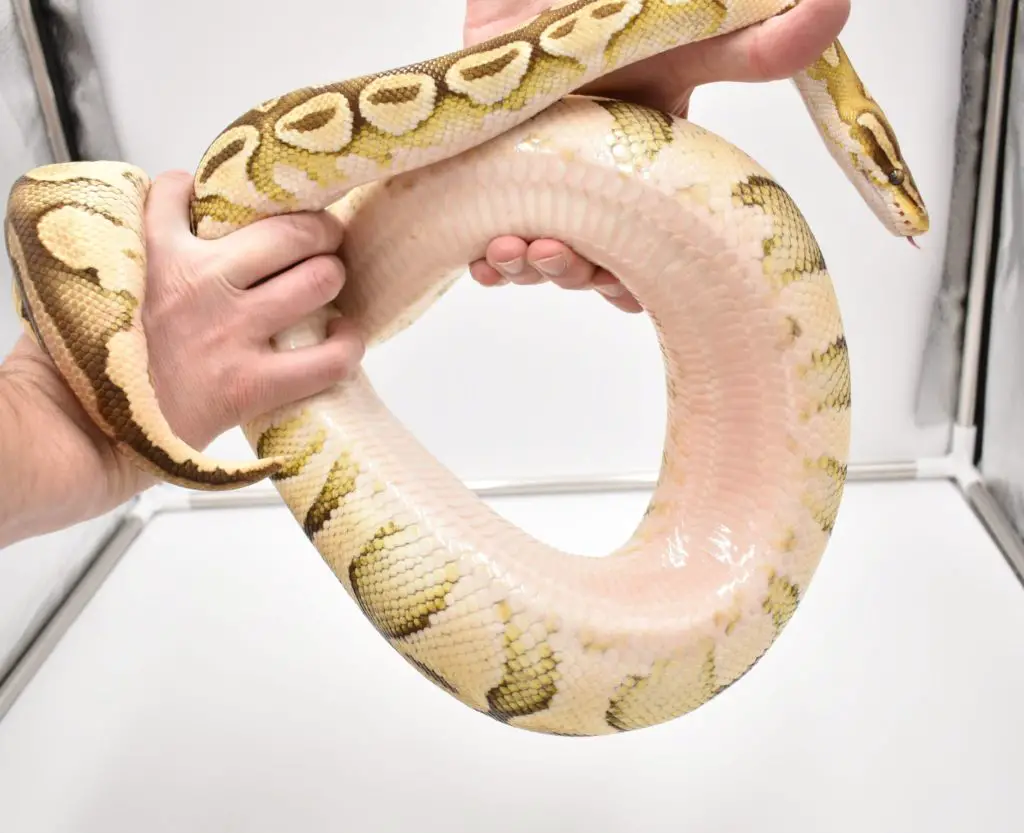
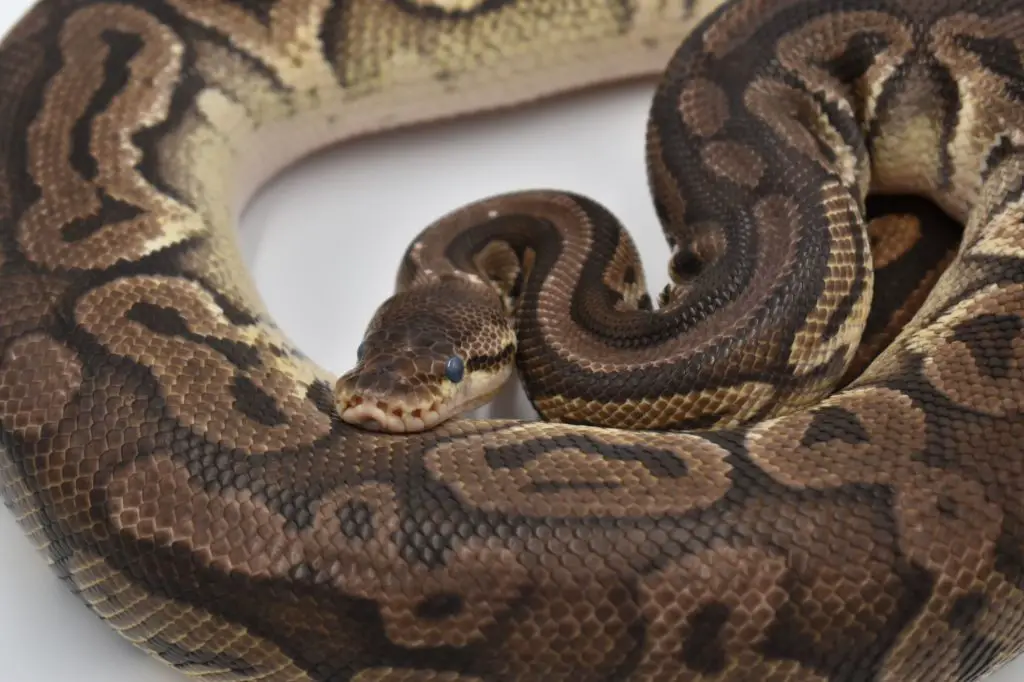
Table: the four stages of shedding and what you must do
| Shedding stage | Action needed |
| 1. Dark colouration | – monitor humidity closely |
| 2. Pink belly | – stop handling |
| 3. Blue eyes | – increase humidity to 80% |
| 4. Clear eyes and shed | – maintain humidity at 80% until shed – after shed, clean enclosure and reduce humidity to 55-65% |
How often do ball pythons shed?
Juvenile/hatchling ball pythons should shed once a month, whereas older animals (2-6 yrs old) should shed every 6 weeks at most. Some old animals will even shed as little as once every 8-9 weeks. If a juvenile sheds more than once every 3 weeks, or an adult more than once a month, I suggest a vet appointment to rule out parasites or skin disease.
One of the main functions of shedding is indeed to facilitate growth, but it’s also a great way of healing wounds and sloughing off external parasites. In some cases, even mild cutaneous infections can be healed with a shed.
Due to the hormonal influence, shedding also seems to punctuate the Ball Python life cycle. Roughly a week after hatching, hatchlings will shed their skin, and this is a sign of a healthy baby. In fact, most hatchlings will refuse their first meal until this shed is over. Likewise, female Ball Pythons will shed after ovulation and roughly one month before laying eggs.
Overall, shedding should be a regular occurrence that tells you your snake is growing and healthy. Don’t forget that most animals do stop feeding while shedding, though. This is perfectly normal and nothing to worry about.
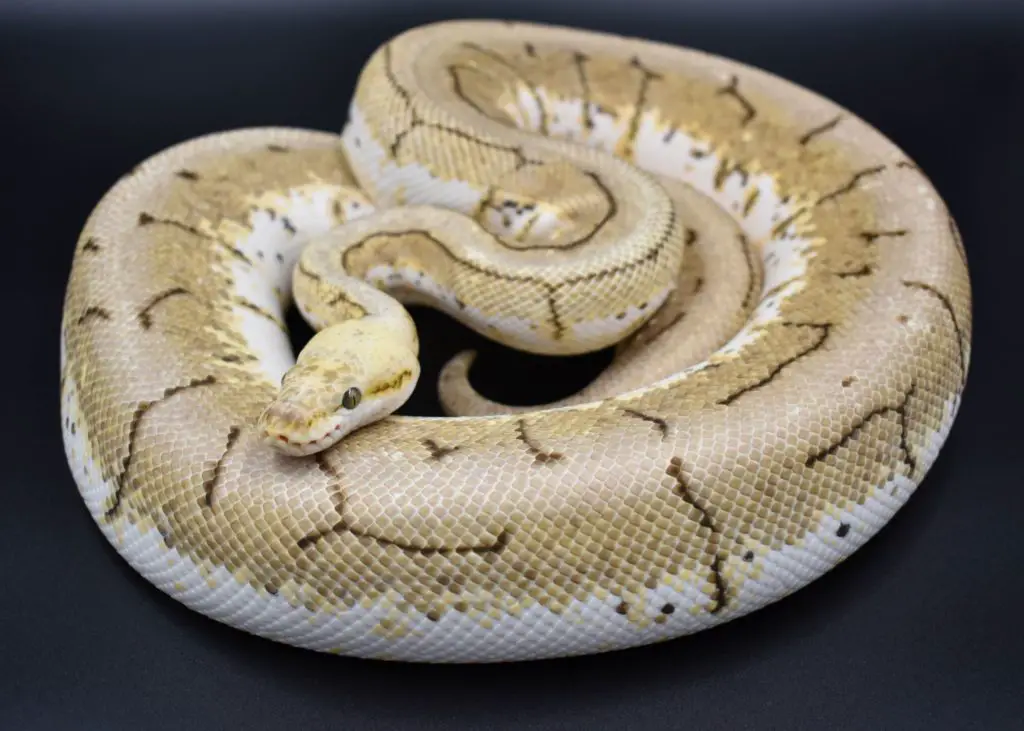
How do you help a ball python shed its skin?
Obviously, you’re putting in effort to maintain good humidity and look after your snake (you’re reading this post after all!), but a bad shed happens to everyone sooner or later. I’ve had it happen and so has every other long-term keeper. Last time it happened to me was when my central heating lowered the humidity in my house and caught me by surprise!
If your humidity is too low, your hygrometer will be reading under 55% and your snake will feel crispy to the touch. Sometimes their eye caps will even dimple. If a shed happens during low humidity, issues like retained skin and eye caps can happen.
Let’s look at some tips for dealing with bad sheds and shedding in general
- Provide a hide box filled with damp spaghnum moss or put some in your snake’s favourite hide.
- After the blue eye stage, spray the whole enclosure twice a day and aim for 80% humidity.
- Spray some water around the hide your snake is in so that it becomes damp underneath.
- If your snake has already started shedding but it is incomplete, try this method to make a soak tub: fill a plastic tub with crumpled newspaper. Fill it with lukewarm water (85°F/29°C), to just above the top of the paper and put two small ventilation holes in either side of the tub. Leave the snake in the tub for 10-15 minutes then remove it. Do not let it get cold during this process! Mist the snake’s enclosure before putting it back in and check in the morning.

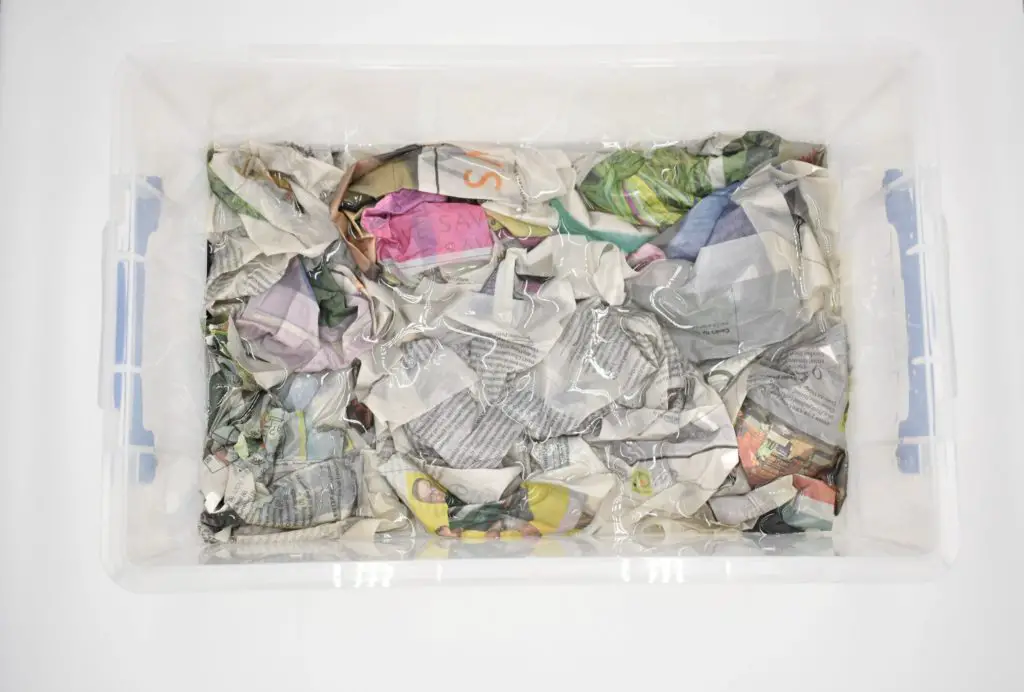
The photos above show how to set up a soak box. As you can see, the water level is not much higher than the newspaper, this way the snake can rest on top without fear of drowning. Don’t forget small ventilation holes.
After a shed is complete – difficult or not, return humidity levels back tot the 55-65% area. These measures are temporary!
Can you handle a Ball Python while it’s shedding?
I strongly recommend that you do not handle your Ball Python while it is shedding if you can avoid it. This is a very stressful time for the snake. It feels groggy and stressed from the physical changes it is undergoing. It is also visually impaired when its eyes are opaque – this will make it even more stressed as it will feel unable to defend itself.
Ball Python Humidity and Shedding go hand in hand
As you can tell from this article, healthy shedding and humidity are intrinsically linked. Maintaining good humidity can make shedding go much more smoothly, which in turn helps reduce stress on your pet. It’s a good idea to familiarise yourself with the four stages of shedding I’ve described and learn to spot them.
Along with the other tips I’ve listed, this will go a long way to preventing shedding issues. Aim for that nice, 55-65% humidity range and you will avoid most problems before they start!
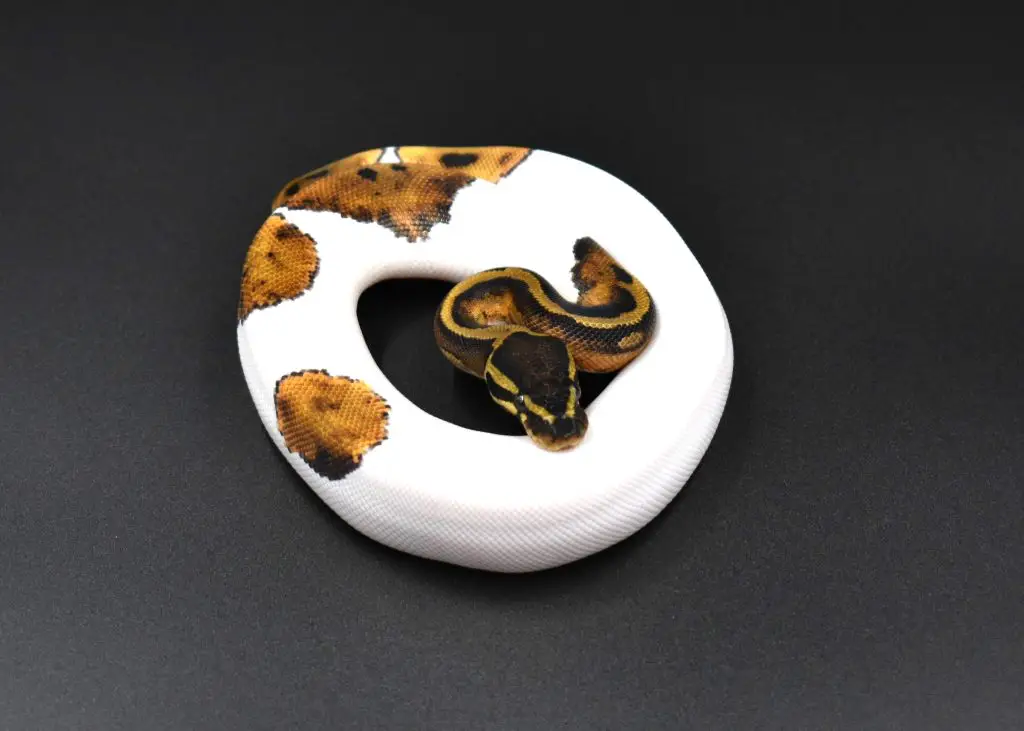
FAQ relating to Ball Python humidity
Is 70% humidity too high for ball python?
70% humidity is just a little too high for a Ball Python. Always aim for a humidity level between 55 and 65%, with more humid hiding places available. It is true that the humidity level in their natural habitat regularly exceeds 70%, but in captivity it is extremely hard to provide the same ventilation. It’s best to play it safe rather than risk illness.
Is 80% humidity okay for ball python?
80% humidity is only ok for a Ball Python that is just about to shed. When its eyes have turned blue, you can raise the humidity to 80% to help it shed, then lower it again to 55-65% right afterwards.
You should never maintain high humidity levels for too long, as the excess moisture allows rapid germ growth in the enclosure. Long-term excess humidity can even play a role in causing diseases like scale rot (necrotizing dermatitis) or respiratory infections.
How humid should a ball python tank be?
A Ball Python tank should be humid enough for optimum skin and lung health. This means between 55-65%. Below 55% and your snake will have trouble shedding. Its scales may also feel brittle or rough. On the other hand, above 65% leads to a lot of microbial growth in the enclosure and increases the chance of infections setting in.
Though high humidity is often blamed for respiratory infections, theres is significant evidence emerging that low humidity can also cause them. This is probably because it harms the mucus membranes of the lungs, deteriorating their surface and allowing germs to infiltrate.
Can you over humidify a ball python?
You certainly can over humidify a Ball Python, and the result is usually scale rot. This happens regularly in bio active enclosures, where deep layers of moist substrate mean the snakes can never really get dry.
Do a quick search on Youtube, and you’ll quickly find so-called reptile “experts” explaining how they treat scale rot in their Ball Pythons that live in these enclosures. For some reason, they usually blame the weather, nature, or some other excuse rather than the setup itself.
To be clear: your Ball Python should be kept at 55-65% humidity and should NEVER get scale rot!
Also on this topic:
For more on water, humidity, and shedding:
Back to the water and humidity topic page
